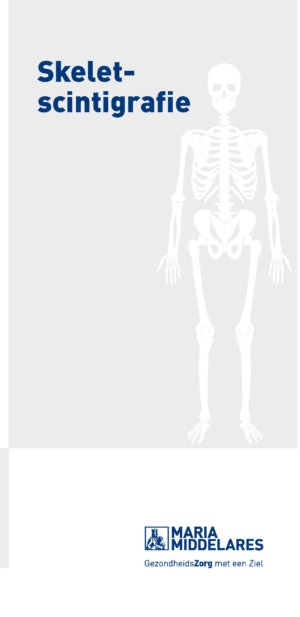Bone scan
What is it?
What is it?Scintigraphy is a type of scan. A slightly radioactive substance is injected which, over the course of several hours, will build up in all bones. This will provide us with information about the entire skeleton.
This technique is useful for a wide range of bone and joint disorders (such as arthrosis, fractures, inflammations, metastases, etcetera) and also for evaluation after orthopaedic procedures.
Course of the procedure
Course of the procedurePregnancy and breastfeeding
Are you pregnant or do you think you may be pregnant? Or are you breastfeeding? Please tell the physician before the injection. The test will not be performed if you are pregnant. If you are not sure whether you are pregnant or not, the test will be postponed until you are certain.
If you are breastfeeding, make sure to discuss this with the physician before the test. You will receive additional instructions about how to avoid unnecessary radiation exposure to your child.
Preparation for the test
No specific preparation is required: fasting is not required and any medication may be taken as on other days.
It is recommended to drink a few glasses of water which will make you pass more urine. Do take into account that there is always a period of at least two hours that you need to wait after the injection before the actual scintigraphy is performed. You do not need to remain in the hospital during these hours.
Procedure
A radioactive tracer material is injected, usually intravenously in the arm. Apart from the sting, you will not notice the injection. Allergic reactions to this substance are very rare. No nausea or sleepiness occurs. It is safe to drive after the procedure.
In case of inflammation, we sometimes take ‘spot’ images (for about five minutes) immediately after the injection to visualise blood flow.
To perform the rest of the scintigraphy, a wait of two to six hours is required until the administered substance is absorbed by the skeleton. When the injection is administered, you will be told the time that you are expected back at the department. Until this time, you may leave the hospital and you are allowed to eat.
Because part of the injected substance is secreted in the urine, we ask you to drink at least one extra litre of water and to urinate as much as possible too. Make sure you urinate in a seated position. This applies to men as well. Always flush and wash your hands after urinating.
Images are taken at the appointed time. The bladder needs to be empty for this, so you will be asked to urinate once more before the test.
In total, the scan takes 20-45 minutes. We usually start with an overview of the entire body. The camera will move close to your body but will not touch it. Do not hesitate to tell us if you suffer from claustrophobia. The camera is an open scanner. You will not be placed inside a tunnel. Three-dimensional recordings ('SPECT') are often required afterwards, with the camera rotating around you to scan the body parts that need examining in all directions. We often combine this with a CT scan.
After the test
You may leave the department after the scan.
Safety and radiation
Safety and radiationThere are essentially no side effects: the injected product causes no abnormal sensations and only in very rare cases causes (very mild) allergic reactions. The injected radioactive material does constitute a dose of radiation, but it is very small (about as much as for a regular CT scan).
The quantity of radiation that you are exposed to during the test is not higher or lower depending on the number of images taken. The radioactive substance will have disappeared almost completely from your body after 12 hours.
It is recommended that children younger than the age of 6 do not sit on your lap for more than half an hour during the first 12 hours after the test. Playing, feeding, changing sheets and nappies and other daily activities are no problem.
Prolonged contact (longer than one hour) in close proximity (less than one metre) with pregnant women during the first 12 hours should be avoided too.
Results
ResultsWe prepare a report of the test. That report and the images are digitally available to the physician who requested the test.
Leaflet
LeafletOnly available in Dutch:

Skeletscintigrafie
DownloadCentres and specialist areas
Centres and specialist areas
Latest publication date: 16/05/2024
Supervising author: Dr Van Den Bossche Bieke



